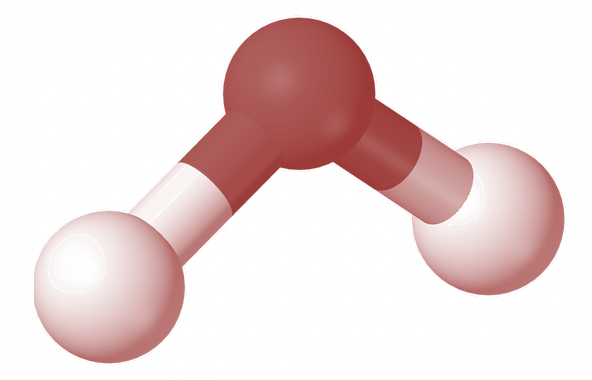Answer
396.6k+ views
Hint: Degree of freedom is the number of independent motions a particle can undergo. To find out the degree of freedom we have to find the number of independent motions possible for that particular molecule. Here we have a triatomic gas and in order to find its degree of freedom, we check its possible motions in x, y and z directions.
Complete step by step answer:
We have to find the Degree of freedom of a triatomic molecule. A triatomic gas molecule has 3 atoms in it.

Consider a triatomic gas molecule as shown in the figure above.
We now consider the possible movements of this molecule in the x, y and z axis.
Here this triatomic gas can have a translatory motion along the x, y, and z axis. I.e. triatomic molecules can move along x direction, y direction and z direction.
Hence the translatory degree of freedom of this molecule is 3
Now let us consider the rotational degree of freedom of this molecule.
For that we place two atoms of the molecule on the x axis. Then it can rotate about y axis and z axis. It also has a significant rotation about x axis because here the third atom has a moment of inertia about x axis even if the other two atoms do not have the inertia.
And thus the rotational degree of freedom of this molecule is also three.
Hence the degree of freedom= Translatory degree of freedom + Rotational degree of freedom
=3+3=6
Therefore at moderate temperature the degree of freedom of a triatomic gas equals to 6.
So, the correct answer is “Option A”.
Note: We can also find the degree of freedom by using the general expression
Degree of freedom, $\text{DF=3N-n}$ where N is the total number of particles and n is holonomic constraints.
We have a triatomic molecule. And hence the number of particles, $\text{N=3}$. And since the separation between 3 atoms is fixed, the number of holonomic constraints, $\text{n=3}$.
Therefore we have,
$\begin{align}
& \text{DF=3 }\!\!\times\!\!\text{ 3 - 3} \\
& \text{DF=9 - 3} \\
& \text{DF=6} \\
\end{align}$
Thus the degree of freedom of a triatomic molecule is 6.
Complete step by step answer:
We have to find the Degree of freedom of a triatomic molecule. A triatomic gas molecule has 3 atoms in it.

Consider a triatomic gas molecule as shown in the figure above.
We now consider the possible movements of this molecule in the x, y and z axis.
Here this triatomic gas can have a translatory motion along the x, y, and z axis. I.e. triatomic molecules can move along x direction, y direction and z direction.
Hence the translatory degree of freedom of this molecule is 3
Now let us consider the rotational degree of freedom of this molecule.
For that we place two atoms of the molecule on the x axis. Then it can rotate about y axis and z axis. It also has a significant rotation about x axis because here the third atom has a moment of inertia about x axis even if the other two atoms do not have the inertia.
And thus the rotational degree of freedom of this molecule is also three.
Hence the degree of freedom= Translatory degree of freedom + Rotational degree of freedom
=3+3=6
Therefore at moderate temperature the degree of freedom of a triatomic gas equals to 6.
So, the correct answer is “Option A”.
Note: We can also find the degree of freedom by using the general expression
Degree of freedom, $\text{DF=3N-n}$ where N is the total number of particles and n is holonomic constraints.
We have a triatomic molecule. And hence the number of particles, $\text{N=3}$. And since the separation between 3 atoms is fixed, the number of holonomic constraints, $\text{n=3}$.
Therefore we have,
$\begin{align}
& \text{DF=3 }\!\!\times\!\!\text{ 3 - 3} \\
& \text{DF=9 - 3} \\
& \text{DF=6} \\
\end{align}$
Thus the degree of freedom of a triatomic molecule is 6.
Recently Updated Pages
Assertion The resistivity of a semiconductor increases class 13 physics CBSE

The branch of science which deals with nature and natural class 10 physics CBSE

What is the stopping potential when the metal with class 12 physics JEE_Main

The momentum of a photon is 2 times 10 16gm cmsec Its class 12 physics JEE_Main

How do you arrange NH4 + BF3 H2O C2H2 in increasing class 11 chemistry CBSE

Is H mCT and q mCT the same thing If so which is more class 11 chemistry CBSE

Trending doubts
Difference Between Plant Cell and Animal Cell

Difference between Prokaryotic cell and Eukaryotic class 11 biology CBSE

Fill the blanks with the suitable prepositions 1 The class 9 english CBSE

Change the following sentences into negative and interrogative class 10 english CBSE

Summary of the poem Where the Mind is Without Fear class 8 english CBSE

Give 10 examples for herbs , shrubs , climbers , creepers

Write an application to the principal requesting five class 10 english CBSE

What organs are located on the left side of your body class 11 biology CBSE

What is the z value for a 90 95 and 99 percent confidence class 11 maths CBSE



